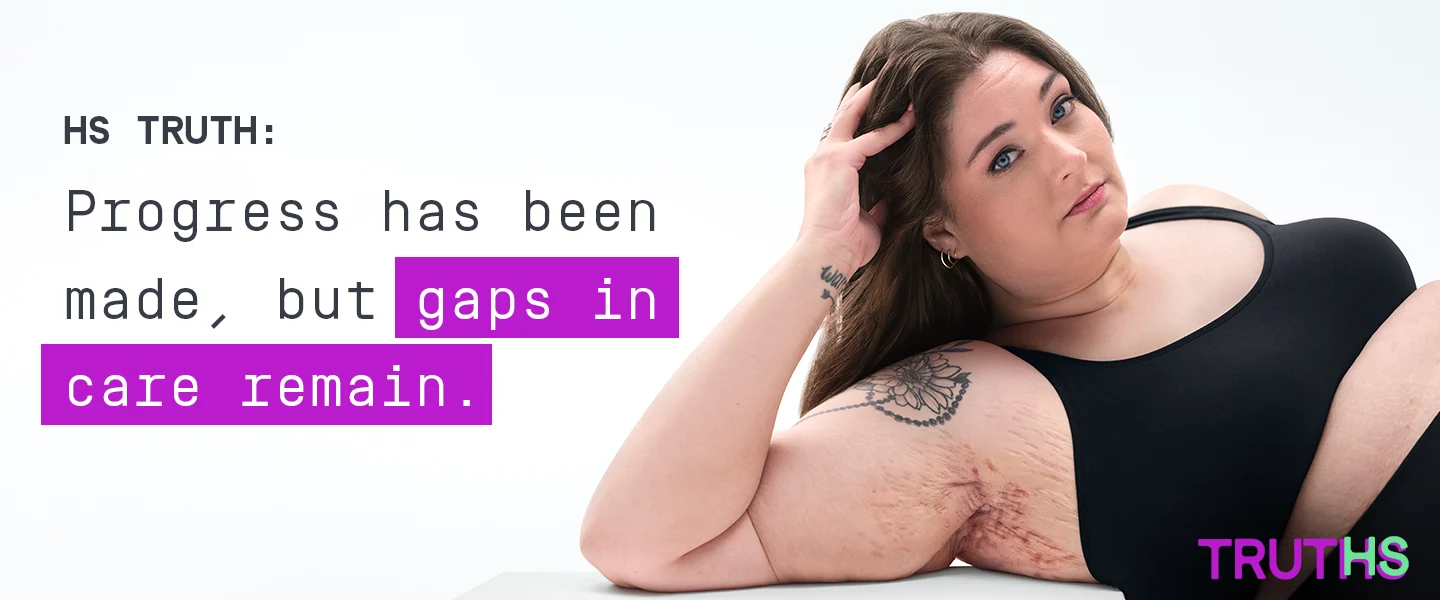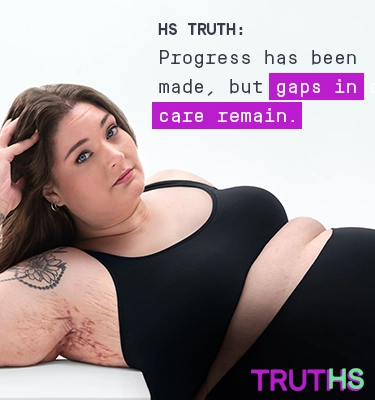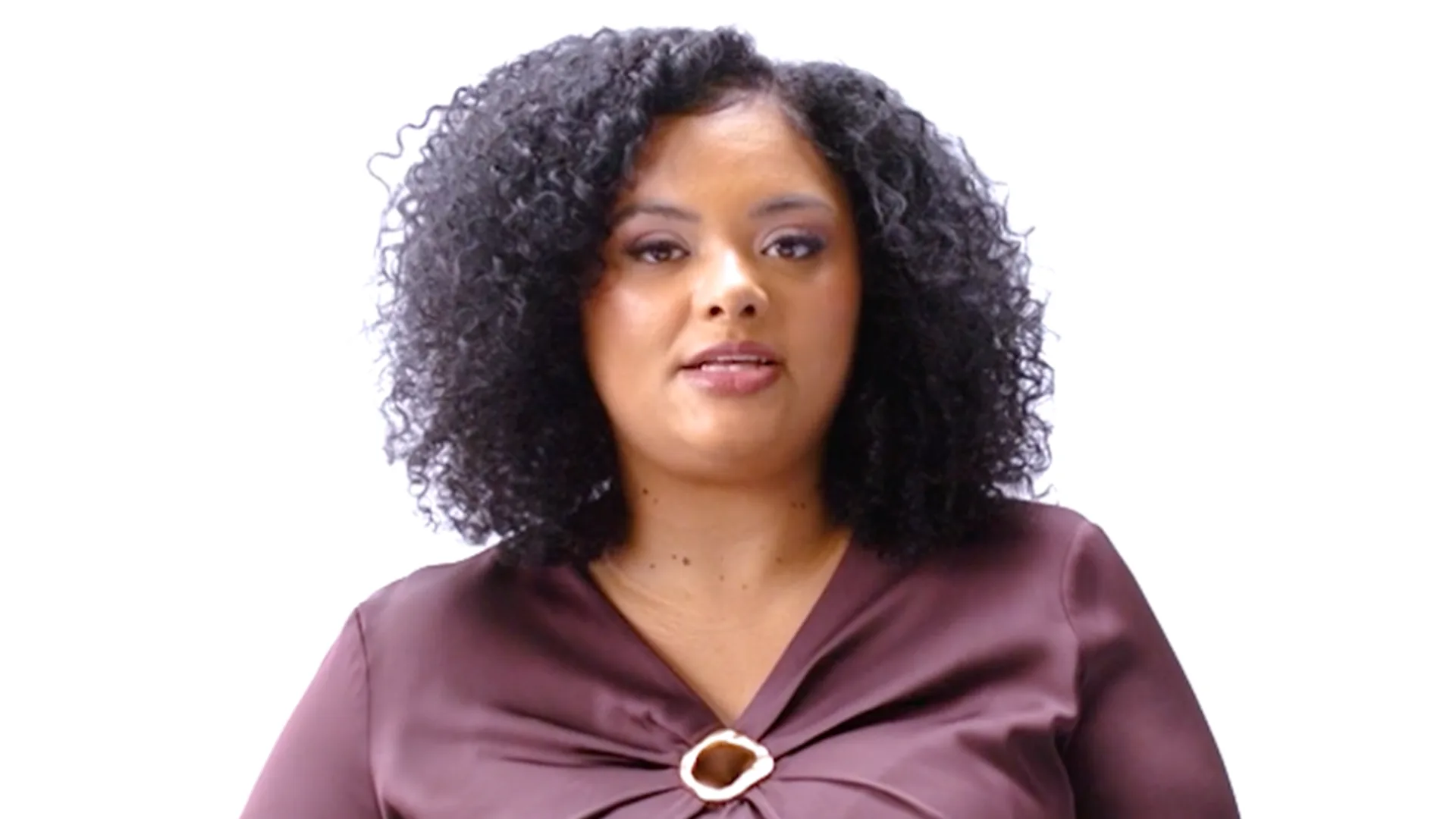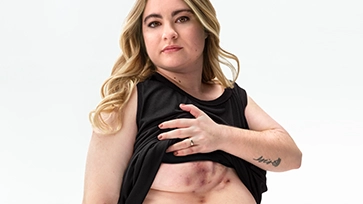HS care has come a long way, especially with the advent of treatments that address underlying inflammation, but earlier diagnosis and treatment remain key to better outcomes and may help prevent disease progression and irreversible tissue damage. Yet HS continues to lack the attention often given to other chronic skin conditions—especially when it comes to therapeutic action.1,2
HS diagnosis WAS FOUND TO TAKE
far longer than psoriasis (~1.6 years), leading to poorer outcomes for HS patients3-5
In a recent survey,
74%
OF HS patients were unaware of FDA-approved treatments
and over half hadn’t discussed them with their doctor6
In a recent survey,
82%
of people with HS remain unsatisfied with their current treatment options6
Antibiotics have long been a mainstay in HS management, but their use is largely based on clinical experience, not robust trial data. Additionally, with high antibiotic usage comes rising concern for antibiotic resistance, which can reduce treatment effectiveness and increase susceptibility to infections.7 To help mitigate this risk, when response is inadequate, alternative therapeutic or procedural options should be considered.7,8
MOMENT OF TRUTH:
If there's no improvement with antibiotics after 3 months,
consider additional treatment options9
Learn how Incyte is committed to raising awareness for HS
HS, hidradenitis suppurativa.
REFERENCES: 1. Krueger JG, Frew J, Jemec GBE, et al. Hidradenitis suppurativa: new insights into disease mechanisms and an evolving treatment landscape. Br J Dermatol. 2024;190(2):149-162. doi:10.1093/bjd/ljad345 2. Sabat R, Alavi A, Wolk K, et al. Hidradenitis suppurativa. Lancet. 2025;405(10476):420-438. doi:10.1016/S0140-6736(24)02475-9 3. Midgette B, Strunk A, Akilov O, et al. Factors associated with treatment satisfaction in patients with hidradenitis suppurativa: results from the Global VOICE project. Br J Dermatol. 2022;187(6):927-935. doi:10.1111/bjd.21798 4. Saunte DM, Boer J, Stratigos A, et al. Diagnostic delay in hidradenitis suppurativa is a global problem. Br J Dermatol. 2015;173(6):1546-1549. doi:10.1111/bjd.14038 5. Garg A, Neuren E, Cha D, et al. Evaluating patients’ unmet needs in hidradenitis suppurativa: results from the Global Survey of Impact and Healthcare Needs (VOICE) project. J Am Acad Dermatol. 2020;82(2):366-376. doi:10.1016/j.jaad.2019.06.1301 6. Murdock A, Whiting C, Azim SA, et al. The state of the clinical management union: a cross-sectional survey of persons with hidradenitis suppurativa. J Drugs Dermatol. 2025;24(4):381-385. doi:10.36849/JDD.8867 7. Fischer AH, Haskin A, Okoye GA. Patterns of antimicrobial resistance in lesions of hidradenitis suppurativa. J Am Acad Dermatol. 2017;76(2):309-313.e2. doi:10.1016/j.jaad.2016.08.001 8. Patel S, Hu JK, Finberg A, Eckembrecher DG, Eckembrecher FJ, Nouri K. Evaluating the inpatient burden of antimicrobial resistance in hidradenitis suppurativa hospitalizations: a cross-sectional analysis. Arch Dermatol Res. 2024;316(5):131. doi:10.1007/s00403-024-02860-1 9. Alikhan A, Sayed C, Alavi A, et al. North American clinical management guidelines for hidradenitis suppurativa: a publication from the United States and Canadian Hidradenitis Suppurativa Foundations: part II: topical, intralesional, and systemic medical management. J Am Acad Dermatol. 2019;81(1):91-101. doi:10.1016/j.jaad.2019.02.068



